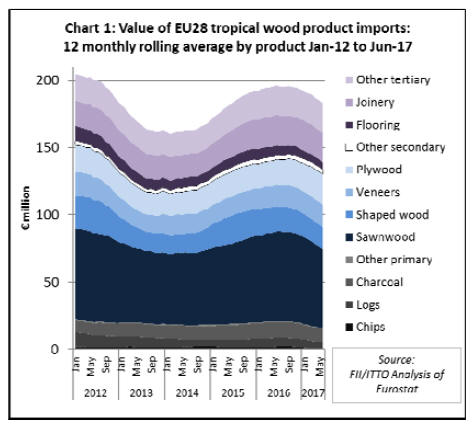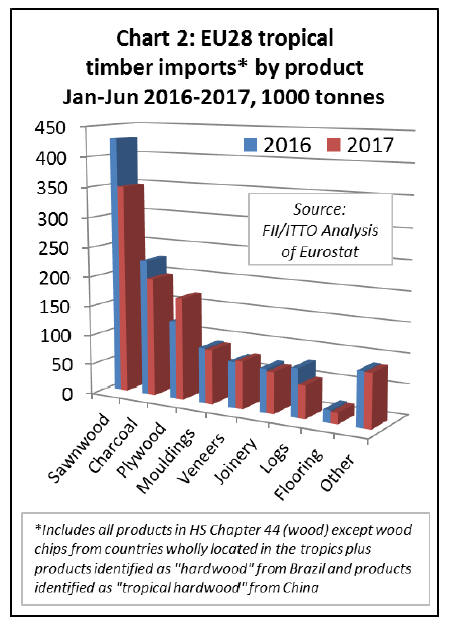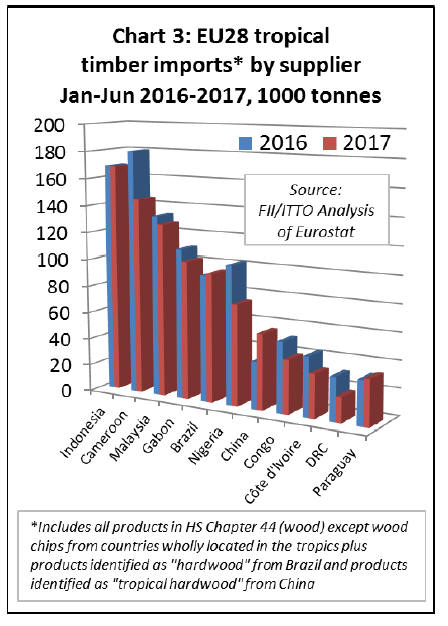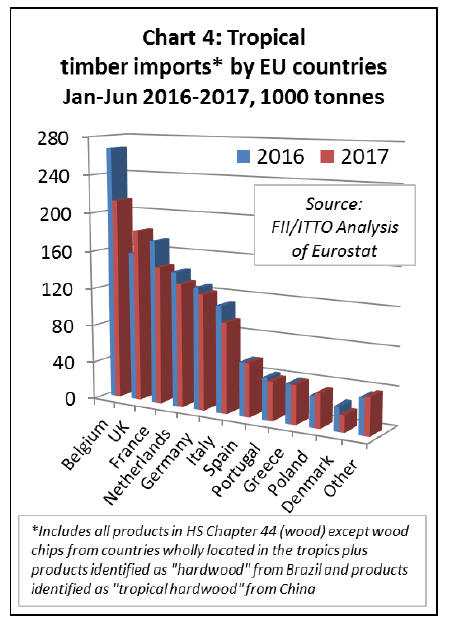|
Report from
Europe
Slowing pace of EU tropical timber imports during first
half
The slowdown in EU imports of tropical timber products
registered in the first quarter of 2017 continued into the
second quarter. Twelve monthly rolling average imports,
which peaked at just below Euro196 million in June 2016,
fell to Euro183 in June 2017. Most of the rise and
subsequent slowdown in EU tropical imports was driven
by sawn wood. (Chart 1).

The decline in EU tropical wood imports this year is, in
some ways, even more troubling than other larger
downturns which have regularly afflicted the European
trade in the last decade. The downward trend runs contrary
to broader economic conditions across the continent
which, while hardly buoyant, are more robust than at any
previous time in the last five years.
The downturn comes at a time when EU tropical wood
imports have barely recovered from the all-time low of
2013 and affects nearly all products and EU markets.
Only plywood and veneer imports rise in first quarter
In the first half of 2017 compared to the same period in
2016, total EU imports of tropical timber products
declined 8% to 1.12 million metric tonnes (MT).
There was an 18% decline in EU imports of tropical sawn
to 349,000 MT, a 13% decline in imports of tropical
charcoal to 199,000 MT, a 33% decline in imports of
tropical logs to 54,000 MT, and an 11% decline in imports
of tropical flooring to 19,000 MT.
These losses were only partly offset by a 31% rise in
imports of tropical plywood to 171,000 MT and a 3% rise
in imports of tropical veneer to 78,000 MT. (Chart 2).

The EU imported 168,000 MT of tropical timber products
from Indonesia in the first 6 months of 2017, exactly
equivalent to the same period in 2016. This is much less
than hoped since Indonesia became the first country to
issue FLEGT licenses in November 2016. However,
Indonesia has performed better than nearly all other
tropical timber supplying countries in the EU market this
year.
EU imports declined from all other major tropical
supplying countries in the first half 2017, with the lone
exception of Brazil. Imports from Brazil were 95,000 MT
during the period, a slight (2%) increase compared to the
first half of 2016.
EU imports of tropical products (nearly all plywood) also
increased 60% from China to 56,000 MT in the first half
of 2017.
In contrast, direct EU imports of tropical products from
Cameroon declined 20% to 145,000 MT, Malaysia
declined 4% to 128,000 MT, Gabon declined 8% to
102,000 MT, Nigeria declined 27% to 75,000 MT (mainly
charcoal), Congo declined 24% to 40,000 MT, Côte
d'Ivoire declined 27% to 32,000 MT and DRC declined
43% to 19,000 MT. (Chart 3).

After rising strongly in 2016, imports of tropical timber
products in Belgium declined 21% to 212,000 MT in the
first half of 2017. Imports in France, Germany and Italy,
which were sliding in 2016, declined further in the first
half of 2017.
Imports fell 16% to 146,000 MT in France, 5% to 122,000
MT in Germany and 16% to 95,000 MT in Italy. After
showing signs of recovery last year, imports in the
Netherlands weakened in the first half of 2017, falling 8%
to 131,000 MT. (Chart 4).

Improving Euro zone economies not lifting tropical
imports
The decline in tropical wood imports into eurozone
countries is surprising given evidence of improving
economic conditions in the region. Growth in the eurozone
picked up to its fastest pace since 2011 in the second
quarter of this year, with GDP in the past 12 months rising
by 2.2%.
In the three months to June the eurozone economy grew
by 0.6%, matching the same healthy number from the first
quarter of the year. German GDP grew by 0.6% in the
quarter, Spain¡¯s by 0.9%, France¡¯s by 0.5% and the
Netherlands by an unexpectedly strong 1.5%.
This positive trend has contributed to a sharp increase in
the euro-dollar rate, from 1.05 in early January 2017 to
nearly 1.20 by the end of August. It¡¯s possible that this rise
in rates is acting temporarily to discourage imports. EU
buyers are often unwilling to build stock at a time when
euro import prices are falling and they anticipate further
price decreases in the future.
It is significant that the UK is the only major EU market
where tropical wood imports held up well in the first half
of 2017. UK imports increased 21% to 90,000 MT during
the period.
Again, this seems to conflict with underlying economic
trends. The UK grew by 0.3% in the second quarter of
2017, a significantly slower rate of increase than the major
eurozone economies. Much of this growth was driven by
the service sector. Industrial output shrank by 0.4% and
construction contracted by 0.9% during the same period as
uncertainty has mounted since the Brexit vote.
This uncertainty is also reflected in exchange rates. The
British pound has weakened sharply against the euro and
stayed quite flat against the dollar this year. In contrast to
eurozone importers, those in the UK had an incentive to
build stock in the first half of 2017 in expectation of a
further weakening in the exchange rate and rising import
prices later in the year.
If the divergent trend in UK and eurozone imports of
tropical timber in the first half of 2017 is driven mainly by
short-term changes in exchange rates, then a reversal may
be expected in the second half of the year - UK imports
are likely to slow and eurozone imports to rebound again.
However, if the downward trend in the EU tropical timber
trade continues, even as economic activity recovers in the
eurozone, then it will be necessary to look to more
fundamental causes.
It is possible, for example, that the combined effect of
increased EUTR enforcement, limited availability of
independently certified or legally verified tropical timber,
the difficulty of demonstrating negligible legality risk in
the absence of such certification, the existence of large
alternative markets where there is still little demand for
such assurances, and the further development of wood and
non-wood substitutes, will be a long-term and ever
deepening slump in the EU market for tropical timber
products.
|